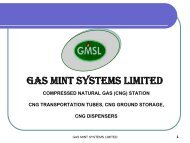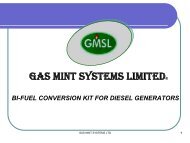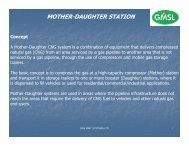Corporate Profile/Brochure - Gas Mint Systems Limited
Corporate Profile/Brochure - Gas Mint Systems Limited
Corporate Profile/Brochure - Gas Mint Systems Limited
Create successful ePaper yourself
Turn your PDF publications into a flip-book with our unique Google optimized e-Paper software.
<strong>Gas</strong> Train<br />
Conditioning and regulating the natural gas prior to admission into the engine is a critical<br />
part of the Bi-Fuel System. The system “gas train” includes a 50-micron fuel filter, an<br />
electrically-operated solenoid valve, actuated in the event of an emergency or for system<br />
shutdown, and a zero pressure, demand-type gas pressure regulator. This latter<br />
component reduces the inlet gas pressure (3 ±1 psi) to roughly atmospheric pressure.<br />
With a negative outlet pressure, the design allows the system to use a “demand” control<br />
scheme whereby engine intake airflow determines the gas flow of the engine. As engine<br />
load changes, corresponding changes in intake air volume automatically draw additional<br />
fuel into the mixer.<br />
Integrated Mixer Throttle Body<br />
Flame Detector<br />
<strong>Gas</strong> Detector<br />
Typically, gas is introduced downstream of the engine air cleaner and upstream of the<br />
turbocharger. The gas is supplied at approximately atmospheric pressure using a<br />
proprietary air-fuel mixer that allows for a high level of gas mixing with the least possible air<br />
restriction. The air-gas mixture is compressed in the turbocharger and distributed to each<br />
cylinder by the engine air intake manifold. The lean air-gas mixture is compressed during<br />
the compression stroke of the piston and ignited by the diesel injector. Since the air-gas<br />
mixture is maintained in a lean condition, pre-ignition does not occur.<br />
Flow of gas to the engine is load dependent and varies with combustion airflow changes.<br />
The Bi-Fuel System varies gas flow according to changes in engine vacuum level. This<br />
allows it to respond to engine fuel requirements while maintaining the integrity of the OEM<br />
governing system. The standard Bi-Fuel System incorporates an integrated Mixer Throttle<br />
Body that varies the gas flow base on the power output from the generator. Diesel injection<br />
is controlled by the OEM governing system during both gas and diesel modes.<br />
The Bi-Fuel Control panel with ECU monitors various engine and system parameters such<br />
as manifold air pressure and temperature, exhaust gas temperature, gas pressure and<br />
engine vibration. This information allows the controller to determine when to activate or<br />
deactivate bi-fuel operation depending on engine performance, load level, ambient<br />
temperature, knock limits or gas supply pressure levels.<br />
9





